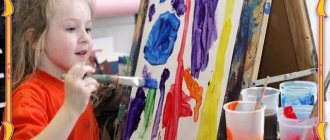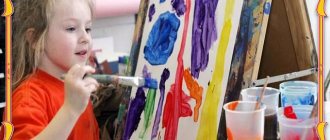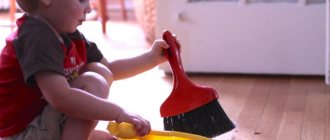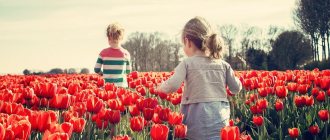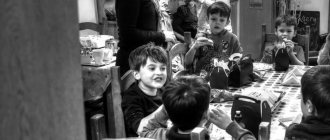Aesthetic education is implemented at every stage of personal development. It becomes more effective the earlier the child enters the sphere of targeted aesthetic influence, which should be uniform and combine all activities, any aspects of his life.
The aesthetic education system is aimed at:
- Creating in children a set of elementary knowledge and impressions, on the basis of which an interest in aesthetic phenomena and artistic objects is formed.
- Development of abilities for aesthetic experiences, formation of personality qualities that will allow one to appreciate highly artistic objects and phenomena and provide the opportunity to enjoy their contemplation and possession.
- Awakening creative abilities in students. An aesthetically developed personality becomes an active creator, trying to bring his life and everything that surrounds him into submission to the learned canons of beauty.
The main wealth for society is a creative personality
In everyday work, in everyday life, and in communication, adults and children encounter aesthetic phenomena. There is beauty and ugliness everywhere. It has a tragic and comic influence on different areas of life. Beauty pleases, stimulates activity, ugliness repels. Comic phenomena help you see shortcomings, tragic phenomena make you sympathize.
Aesthetic education opens the child’s soul to new forms, sounds, colors, helps a deeper understanding of the world, and promotes harmonious development and self-discovery. Developed creative thinking contributes to the search for new ways, including in the field of science, economics, and production.
The tasks of society bring to the fore new demands on people. Since it becomes the main component of the productive forces, it must be fully developed. It is impossible to educate a creative person who has the need for creative activity without the efforts of society and policies specifically aimed at this. Therefore, the most important means of qualitative development of human nature is aesthetic education from a very early age.
Read: Means of aesthetic education.
The concept of aesthetic education and its functions
AESTHETIC EDUCATION is the formation of a certain aesthetic attitude of a person to reality.
In the process of aesthetic education, an individual’s orientation in the world of aesthetic values is developed, in accordance with the ideas about their character that have developed in a given particular society, and familiarization with these values. At the same time, aesthetic education forms and develops a person’s ability for aesthetic perception and experience, his aesthetic taste and ideal, the ability to create according to the laws of beauty, to create aesthetic values in art and outside of it (in the sphere of work, in everyday life, in actions and behavior ).
Thus, aesthetic education has two main functions that constitute a unity of opposites:
formation of aesthetic and value orientation of the individual
development of aesthetic and creative potentials of the individual
These functions determine the place of aesthetic education in public life and the connection with other types of educational activities. Aesthetic education is associated with moral education, since there is unity between aesthetic and ethical values. Beauty, in addition to its other purpose, acts as one of the regulators of human relationships, helping them to become fully human. Thanks to beauty, people are intuitively drawn to goodness even before the idea of goodness is meaningfully perceived by their moral consciousness. Aesthetic education develops all the spiritual abilities of a person necessary in various fields of creativity. The many hours I spent playing the violin. L, Einstein, were not stolen from science, because, according to the physicist’s own testimony, “real science and real music require a homogeneous thought process.”
The conflict between the main functions of aesthetic education arises when the aesthetic “values” in the spirit of which a person is brought up express the interests of the reactionary strata of society and are anti-humanistic in nature (for example, propaganda of cruelty, violence, militarism, nuclear arms race in various types and genres bourgeois mass culture), not only do not require the development of human creative abilities, but, on the contrary, are aimed at dulling them in every possible way. If the formation of personality is assumed in the spirit of truly aesthetic values - those that express the development of freedom and the free development of man and society - then the functions of aesthetic education harmoniously determine each other. For the comprehension of aesthetic values that arise in the process of creative activity cannot but be of a creative nature. Aesthetic education is carried out by many means. This includes the everyday environment of a person’s life, the environment of his work activity, the aesthetic side of moral relations, sports, etc.
The most important factor in the targeted aesthetic influence on a person is art, since it concentrates and materializes the aesthetic attitude. Therefore, artistic education—the cultivation of the need for art, the development of its feeling and understanding, and the ability for artistic creativity—is an integral part of aesthetic education as a whole. The prism of art guides the perception of the aesthetic values of life. Turning to art, a person, as it were, enters a laboratory of creative activity. In other words, art participates in the implementation of both value-oriented and creative functions of aesthetic education. At the same time, aesthetic education through art is not limited to artistic education. It is much broader, because it involves influencing the aesthetic aspects of work, people’s lives, their behavior, as well as the formation of an aesthetic attitude to reality itself. The social basis for the discrepancy between the main functions of aesthetic education is the antagonism between the interests of the individual and society, since for the individual it is directly important to develop his creative abilities, and for society - aesthetic and value orientation in the name of strengthening social integrity.
Principles of aesthetic education
Creative abilities must be developed from birth. From early childhood, one must instill good taste and develop the need to communicate with the sublime. Aesthetic education is aimed at developing the ability to see beauty and following the rules of good behavior, experience of friendly relations with others. Its basis is the following principles:
- Interaction. Any action should strive for aesthetic perfection: communication with peers, nature, objects of art, independent household and work activities.
- A complex approach. Education gives tangible results if creative activity is based on interdisciplinary connections and connects various types of art.
- Socialization. Aesthetic and artistic activity is not divorced from life. This is how students develop an adequate attitude towards their environment; they will be able to find beauty in its various manifestations.
- Systematicity. General and aesthetic development are interconnected. With this approach, the emotional sphere and all cognitive processes develop harmoniously.
- Independent creativity. The method of aesthetic education is most effective when applied to preschool children if they master some creative activities themselves: dancing, drawing, sculpting or singing in a choir.
- Aesthetics should dominate all life. Little children need to live in beauty. The main educational meaning is to understand the importance of accuracy and politeness. Proper aesthetic development is influenced by the beauty of the room and clothing.
- The age of the student is taken into account. Educational means are selected according to age. The formation of personality in more mature years depends on how correctly aesthetic perception was formed in younger schoolchildren.
Domestic and foreign systems of music education
Forms and methods of preschool educational institutions for artistic and aesthetic educationmaterial on the topic
“Forms and methods of preschool educational institutions for artistic and aesthetic education”
In modern society, social and economic changes are taking place. This also affects education, which is at the stage of modernization in connection with the “Federal State Standards for the Structure of the Basic General Education Program of Preschool Education.”
The formation of a creative personality is one of the most important tasks of pedagogical theory and practice at the present stage. The man of the future must be a creator, with a developed sense of beauty and active creativity.
The modern concept of preschool education shows the importance of introducing children to art from an early age, considering it a measure of human values.
Changes in content, complication of the functions of modern preschool educational institutions and educational conditions have caused the need to search for new forms and methods of organizational and pedagogical activity.
That is why many kindergartens pay great attention to the artistic and aesthetic development of their students.
In our time, the problem of artistic and aesthetic education, personal development, the formation of its aesthetic culture is one of the most important tasks facing education in general and preschool education in particular.
Pedagogy defines the artistic and aesthetic education of preschool children as a purposeful process of forming a creatively active personality of a child, capable of perceiving and appreciating the beauty in life and art.”
Thus, artistic and aesthetic education is the formation in a person of an artistic and aesthetic attitude to reality and its activation to creative activity according to the laws of beauty.
Artistic and aesthetic education should form artistic taste, develop and improve in a child the ability of aesthetic awareness of beauty in art and in life, the ability to correctly understand and evaluate it.
Artistic and aesthetic education has an active and creative orientation, which should not be limited only to a contemplative task, it should form the ability to create beauty in art and life.
Communicating with the aesthetic phenomena of life and art, the child, one way or another, develops aesthetically and artistically. But at the same time, the child is not aware of the aesthetic essence of objects, and development is often determined by the desire for entertainment, and without outside intervention the child may develop incorrect ideas about life, values, and ideals.
Academician Likhachev, as well as many other teachers and psychologists, believes that only targeted pedagogical aesthetic and educational influence, involving children in a variety of artistic and creative activities can develop their sensory sphere, provide a deep understanding of aesthetic phenomena, and raise them to an understanding of true art and the beauty of reality. and beauty in the human personality.
The essence of this process can be defined as follows: First, it is the process of purposefully cultivating a sense of beauty. Secondly, it is the formation of the ability to perceive and see beauty in art and life, and appreciate it. Thirdly, the task of artistic and aesthetic education is to form artistic taste. And finally, fourthly, the development of the ability for independent creativity and the creation of beauty, the development of the ability to creatively create artistic products.
The main thing is to educate and develop such qualities, such abilities that will allow the individual not only to achieve success in any activity, but also to be the creator of aesthetic values, to enjoy them and the beauty of the surrounding reality. In addition to the formation of children’s artistic and aesthetic attitude towards reality and art, artistic and aesthetic education simultaneously contributes to their comprehensive development. It contributes to the formation of a person’s morality, expands his knowledge about the world, society and nature. A variety of creative activities for children contribute to the development of their thinking and imagination, will, perseverance, organization, and discipline.
Tasks:
- the first is the creation of a certain stock of elementary aesthetic knowledge and impressions, without which inclination, craving, and interest in aesthetically significant objects and phenomena cannot arise. The essence of this task is to accumulate a diverse stock of sound, color and plastic impressions. The teacher must skillfully select, according to the specified parameters, such objects and phenomena that will meet our ideas about beauty.
In this way, a sensory-emotional experience will be formed. Specific knowledge about nature, oneself, and the world of artistic values is also necessary;
- the second task of artistic and aesthetic education is “the formation, on the basis of acquired knowledge and the development of artistic and aesthetic perception abilities, of such social and psychological qualities of a person that provide her with the opportunity to emotionally experience and evaluate aesthetically significant objects and phenomena, enjoy them”;
- The third task of artistic and aesthetic education is related to the formation of artistic and aesthetic creativity in each student. The main thing is to “educate and develop such qualities, needs and abilities of the individual that turn an individual into an active creator, a creator of aesthetic values, allowing him not only to enjoy the beauty of the world, but also to transform it “according to the laws of beauty.” The essence of this task is that the child must not only know beauty, be able to admire and appreciate it, but he must also actively participate in the creation of beauty in art and life, and independently create creative products.
Most researchers distinguish the following categories: aesthetic perception, aesthetic taste, the formation of an aesthetic ideal and aesthetic evaluation.
Preschool age is the most important stage in the development and education of the individual, the most favorable for the formation of artistic and aesthetic culture, since it is at this age that positive emotions predominate in the child, special sensitivity to linguistic and cultural manifestations, personal activity appear, and qualitative changes occur in creative activity.
Aesthetic education of the individual occurs from the first steps of a little person, from his first words and actions. The effectiveness of aesthetic education directly depends on compliance with the principle of artistic and creative activity and amateur performances of children. Choral singing, folk dancing, playing instruments, writing songs, poems, stories, theatrical performances introduce children to works of art, polish their performing skills, become the content of spiritual life, a means of artistic development, individual and collective creativity, and self-expression of children. According to the theory of self-esteem of the preschool period of a person’s life by A.V. Zaporozhets, the main path of development of a child during preschool childhood is amplification of development, that is, enrichment, filling with the most significant for the child, specifically children’s preschool forms, types and methods of activity. The types of activities that are closest and most natural to a child - a preschooler - play, communication with adults and peers, experimentation, object-based, visual, artistic and theatrical activities, child labor and self-service - occupy a special place in the system of artistic and aesthetic education. But it is artistic activity, saturated with amplification, brightly and emotionally colored from the satisfaction received from engaging in favorite types of artistic activity, that helps, without forcing the child with dry didactics, to achieve by the age of seven the same results as intellectual programs. And, in addition, as a result of artistic and aesthetic education - a spiritually rich, comprehensively developed personality. That is why it is necessary to pay great attention to the artistic and aesthetic development of students. One of the main goals of the teaching staff should be the development of the child’s creative potential and the creation of conditions for his self-realization. To obtain the expected results, a system of work on artistic and aesthetic education must be created in a preschool institution, which consists of interconnected components: updating the content of education (choice of programs and technologies); creating conditions for aesthetic education (staffing, educational, methodological and logistical support, creating a subject-development environment, creating a harmonious design of the territory and premises of the kindergarten); organizing the educational process (working with children and parents); coordination of work with other institutions and organizations.
The system of pedagogical interaction between teachers and children, aimed at the artistic and aesthetic development of preschool children, is being built in preschool educational institutions in three directions:
— specially organized training;
— joint activities of teachers and children;
- independent activity of children.
The interaction between teachers and children is carried out taking into account a differentiated approach and includes various forms of work: group and subgroup classes, holidays, entertainment, themed musical evenings, creativity weeks, didactic games, exhibitions of drawings and crafts, the creation of homemade books, group and studio work; free artistic activity; organization of performances, entertainment, competitions, exhibitions, festivals, holidays; museum pedagogy; aesthetic design of interiors; participation in city events, etc.
The knowledge gained in the aesthetic cycle classes is reflected in the play activities of the students. They enjoy playing music, showing mini-performances, dancing, retelling fairy tales, and doing their own writing.
The “Artistic and Aesthetic Education” program at the preschool educational institution includes introducing children to art, the aesthetics of a developing environment, visual activities (drawing, modeling, appliqué), design and manual labor, musical education, cultural and leisure activities. synthesis of arts; vocals; choreography, theatrical and play activities; all types of productive activities, local history.
The implementation of the tasks of artistic and aesthetic education will most optimally be carried out under the following conditions:
• Maximum consideration of the age and individual characteristics of children.
• The basis of artistic and aesthetic education is art and the surrounding life.
• The relationship between the artistic and creative activities of children themselves and educational work, which provides a variety of food for the development of perception, imaginative ideas, imagination and creativity.
• Integration of various types of art and various types of artistic and creative activities, promoting a deeper aesthetic understanding of reality, art and one’s own artistic creativity; the formation of figurative ideas, figurative, associative thinking and imagination.
• Respectful attitude towards the results of children's creativity, wide inclusion of their works in the life of a preschool educational institution.
• Organization of exhibitions, concerts, creation of an aesthetic development environment, etc.
• Variability of content, forms and methods of working with children in different areas of aesthetic education.
• Ensuring continuity in artistic and aesthetic education between all age groups of kindergarten, as well as between kindergarten and primary school.
Close relationship and interaction between kindergarten and family.
• Wide reliance on regional material, its specifics: nature, art - both classical and folk. Acquaintance with contemporary art and its creators working in a village, city, region. Children’s knowledge of the sights, their surroundings, and significant events.
The conditions for artistic and aesthetic education are very diverse. They depend on many conditions: the volume and quality of artistic information, forms of organization and types of activities, and the age of the child. The basis of aesthetic education is the joint activity of an adult and a child to develop his creative abilities for the perception of artistic values, for productive activity, and a conscious attitude towards the social, natural, and objective environment. Aesthetic perception of life phenomena is always individual and selective. It is based on an emotional response to beauty. A child always responds to the beautiful in nature, the objective world, art, and to the kind feelings of people. The child’s personal experience, his motives, aspirations, and experiences are of great importance.
The artistic and aesthetic development of preschool children is carried out directly in the educational areas: “Cognition”, “Communication”, “Reading fiction”, “Artistic creativity”, “Music”.
The key role of a kindergarten is to create conditions for the formation of a harmonious, spiritually rich, intellectually developed personality. Everything depends on the first preschool experience that the child will receive within the preschool walls, on the adults who will teach the child to love and perceive the world around him, to understand the laws of society, and the beauty of human relationships. Introducing children to art is precisely the “key” that unlocks the creative potential in children and gives them a real opportunity to adapt to the social environment.
Among the methods of artistic and aesthetic education, the following can be distinguished:
- a method of inducing empathy, emotional responsiveness to the beautiful and condemnation of the ugly in the world around us. This method assumes that works of art must be distinguished by high artistry, and when children listen to poetry, fairy tales, and music, it is important not only for the teacher to accurately reproduce the text and musical design, but also for its emotional and imaginative performance. Only in this case can an educational effect be achieved;
- The method of persuasion allows children to develop aesthetic perception and elements of artistic taste. The peculiarity of this method is that it can be used only when the perceived phenomenon is beautiful;
- training method, exercises in practical actions. The teaching method presupposes the child's desire to decorate and improve the environment, that is, to transform it as much as possible and please his peers and adults with this;
- a method of searching situations, encouraging children to be creative. Using this method, the teacher invites children to come up with a story, draw, sculpt according to plan, etc.
Works of art must be present in the educational process.
The first direction is that art, including folk art, is included in the daily life of children as an integral part of the aesthetic environment. Thus, music can be played in and outside of classes, and works of fine art can be used in the design of a preschool institution.
The second direction is that art constitutes the content of education: children are introduced to different types of art, events, phenomena, objects revealed by artists, musicians, writers and poets in their works; with expressive means that allow you to create vivid images of reality.
The third direction is that art is used in various types of artistic activities and serves the development of children's artistic creativity. Images of art are standards of beauty.
The implementation of the curriculum for the artistic and aesthetic development of preschool children requires educators and specialists to constantly improve their pedagogical skills.
Thus, a properly organized system of work on the artistic and aesthetic education of children - the creation of conditions for aesthetic education, the organization of the educational process will create favorable conditions for the development of children's artistic and aesthetic abilities, creative imagination and, as a result of artistic and aesthetic education, spiritual a rich, well-rounded personality.
Forms of organization of aesthetic education
Methods of artistic and aesthetic education have the best results when they are interconnected. Teachers should combine and vary them.
The methods differ in:
- methods of transmitting information;
- practical form of organization.
The methods are divided into:
- visual (when children get acquainted with examples of art);
- verbal (adults tell, explain);
- practical (testing, creative work).
Visual methods (looking at a picture, listening to a piece of music together) suggest the emotional content of the moment. An acquaintance with objects of art should make a vivid impression on the child so that it is remembered.
The form of organization is as follows:
- when adults show an example of an action, they invite the child to repeat a poem or sing a song;
- Teachers invite the child to independently determine how to complete the task: sculpt, cut, or draw something.
It must be remembered that the aesthetic education of preschoolers is somewhat different from the methods of working with school-age children. For children, the emphasis is placed on visual perception; they are gradually brought to realize the importance of cleanliness and order. Older children are able to express their creativity. Preschoolers learn to evaluate, and schoolchildren are already creating a product and have a creative approach in the process of creating an object.
Methods of aesthetic education
The main methods that promote the development of children’s aesthetic senses, the ability to evaluate, and creatively apply acquired knowledge and skills include:
- Method of persuasion. It is used only when the phenomenon being studied is beautiful. Pupils have an emotional response when meeting works of art and participating in a holiday. The method can be considered equally verbal, because Children's observations receive commentary from an adult and awaken thoughts and feelings.
The teacher must select the most impressive works of art and take care of the appropriate mental mood of the children. The subject must be well mastered by the teacher, and the speech must be precise and expressive. When attention is focused on the beautiful, the teacher gives the concept of “what is good and what is bad.”
- Training method. It implies a practical action, an exercise aimed at changing the environment, instilling socially accepted cultural behavior skills. The content of the method is to teach the child to see and appreciate beauty, and to act accordingly.
Systematic exercises and children's artistic practice promote children's activity.
- Method of problem situations. Allows creativity and the desire to act to awaken. The teacher invites the students to find a way to realize their artistic idea themselves. For example, after listening to a fairy tale, children are asked to portray one of the characters. The task can be simple or complicated by the poor choice of the hero. The child learns to think on his own, comes to an independent decision on how best to realize his plans: draw, sculpt, compose a poem.
- Encouraging empathy. A sympathetic person who knows how to empathize and compassion experiences joy from communicating with people, and celebrates successes and victories with them. Children who can sympathize are more open and friendly, they have more friends, and they are less likely to find themselves in conflict situations.
Emotional reading of fairy tales, discussion of illustrations, a puppet show or a musical number will help here.
Traditional methods of influencing students
Story. It should be emotional, have a plot outline, be educational, influence the imagination, but not interfere with self-assessment.
Aesthetic education in a preschool educational institution
Lecture. Dedicated to more complex topics, it is appropriate for classes with older children. Equipping the lesson with visual material will give greater imagery. It is permissible to raise problematic topics, push students into discussion, and persuade them to express their point of view.
Conversation. This is not a teacher’s monologue in front of children, but a mutual emotional exchange of opinions. During the conversation, the teacher uses visual material, interprets scientific concepts, emphasizes certain beautiful characteristics in works of art, work, real and fictional characters in literature, theater, and cinema.
Dispute. Designed to discover and bring together different points of view, raise a problem, and attract children to discuss it. The task of adults is to carry out serious preparatory work to help identify positions, stimulate dialogue, and direct the dispute into a cultural direction.
School education
What objects help develop a child’s culture and introduce him to art? There are three main ones:
- Russian language and literature. School lessons are one of the methods of aesthetic education of children. The teacher tells children about the norms of language, forms beautiful speech, and helps develop good literary taste.
- Art. Methods and techniques of aesthetic education in drawing lessons can be different. It all depends on the mood of the children and their willingness to cooperate with the teacher. Children can draw, sculpt, do appliqué, and make stained glass.
- Music. A good taste in music can be developed by a worthy teacher who is himself interested in music. What methods of aesthetic education of schoolchildren are used in this area? Theoretical lectures are followed by practical exercises. This could be learning songs or attending children's music events.
Education through art
Whatever the methods of education, it is important that they are provided with the necessary conditions:
- developmental environment;
- close interaction with nature and art;
- conditions for the realization of creativity.
At a young age, aesthetic education is distinguished by the fact that children perceive everything around them with their senses. For them, the form and content of an object are inseparable. If a child likes something, he experiences delight and joy. The teacher’s task is to direct this simple mental movement from ordinary perception to a deep understanding of harmony, beauty, and the formation of aesthetic taste.
Important
Proper musical and aesthetic education teaches children not only to understand beauty, but also to find beauty in everyday life: everyday phenomena, nature, work, clothing.
Raising Teens
Many children spend more time at school than at home. What should teachers do to develop good taste in children, besides teaching lessons? A good teacher can conduct the following activities with children:
- Discussions. A popular method and means of aesthetic education are conversations on an abstract topic. In this way, the class teacher can prepare children for public speaking and teach his students how to conduct a harmonious dialogue.
- Visiting theaters. Not all parents have the opportunity to take their children to the theater, so this mission often falls on the shoulders of the class teacher.
- Visiting museums. This is included in the aesthetic education of schoolchildren.
- Class hour. If we describe the method of artistic and aesthetic education of schoolchildren, then we can call it an extracurricular activity. Children, under the guidance of their class teacher, prepare concerts, come up with comedy routines, sing songs, and learn dances.
- Competitions. All kinds of competitions should be held for schoolchildren, where children can demonstrate their talents.
